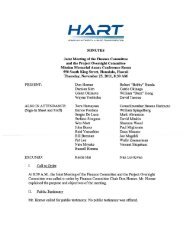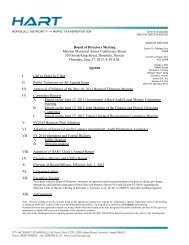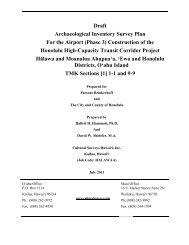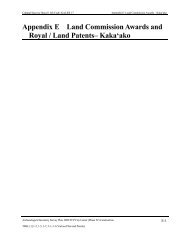4.12 Test Excavation 167 (T-167) - Honolulu Rail Transit Project
4.12 Test Excavation 167 (T-167) - Honolulu Rail Transit Project
4.12 Test Excavation 167 (T-167) - Honolulu Rail Transit Project
Create successful ePaper yourself
Turn your PDF publications into a flip-book with our unique Google optimized e-Paper software.
Cultural Surveys Hawai‘i Job Code: KALIHI 23Kewalo Geographic ZoneThe 2-liter screened sample from SIHP# -7429 Feature 7 yielded shell midden (13.5 g), bottleglass fragments (0.3 g), a fish spine (0.1 g), and fire-cracked rock (25.8 g). The shell middenmaterial was classified as Strombidae (Strombus sp.) (8.5 g), Neritidae (Nerita picea) (2.6 g),Naticidae (Natica sp.) (burned) (2.0 g), burned crustacean (0.3 g), Isognomidae (Isognomon sp.)(0.1 g). Additional faunal remains were encountered within the screened sample from Feature 7,and included material from a dog (Canis lupus familiaris), rat (Rattus sp.), and unknown mediummammal, not consistent with human.The results of sample analysis documented the presence of traditional food refuse includingmarine shell midden and historic artifacts within Stratum II and SIHP# -7420 Feature 7. Thepresence of historic material may indicate disturbance or deposition during the post-Contactperiod.GPR Discussion: A review of amplitude slice maps indicated no linear features which mightindicate the presence of utilities. Reflectivity was relatively uniform throughout the grid anddecreases with depth. A transition from higher reflectivity to lower reflectivity was observed atapproximately 0.25 mbs.GPR depth profiles for T-170A identified horizontal banding, commonly associated withstratigraphic layering, throughout the survey area. This banding corresponded to variations ofdensity and chemical composition within fill deposits. The profile also indicated a change inreflectivity occurring around 0.25 mbs and again around 0.5 mbs. No utilities were observed inthe profile. The maximum depth of clean signal return was approximately 1.2 mbs.Summary: T-170A was excavated to a depth of 1.28 mbs in natural sediment and beneath thewater table at 1.24 mbs. The stratigraphy of T-170A consisted of fill strata (Ia-Id) overlying aculturally-enriched buried A-horizon (II) and natural sediment (III-IV). The stratigraphygenerally conformed to the USDA soil survey designation of Fill land (FL). Faunal remainswere collected during excavation and were considered to be a component of the culturallyenrichedburied A-horizon (Stratum II). A total of two sediment samples were collected fromwitin T-170A including one bulk sediment sample from Stratum II between 0.56-0.60 mbs (11.0L) and the contents of one screened sample from SIHP# -7429 Feature 7 between 0.56-0.60 mbs(2.0 L). The results of sample analysis documented the presence of traditional food refuseincluding marine shell midden and historic artifacts within Stratum II and SIHP# -7420 Feature7. The presence of historic material may indicate disturbance or deposition during the post-Contact period. Stratum II and one associated feature (Feature 7) within T-170A were consideredto be components of SIHP# 50-80-14-7429, a culturally-enriched buried A-horizon.HHCTCP City Center (Section 4) AIS Report, Vol. IV C 807TMK: [1] 1-2, 1-5, 1-7, 2-1, 2-3 (Various Plats and Parcels)
















